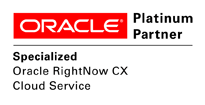Blog by Ed Hague-Holmes
Cache me if you can: Location logging in Oracle B2C Service using a what3words integration
5 min read
This is the second of two blog posts based on a conference we recently attended, organised by Richard Lefebvre (EMEA CRM & HCM Partners Program Director), where Christopher Patterson (Senior Director for Oracle Product Development) discussed the Oracle Service Cloud roadmap for 2014/2015.
This blog post will give an overview of the intended Service Cloud strategic advances coming to the Agent Desktop in the near future, including improvements to Collaboration and a new Browser-based UI. The first of these two blog posts focused on Customer Portals and can be found here.
In the recent August release, Oracle announced the ‘Incident Collaboration Framework’, which allows agents to share incidents with other agents, leveraging knowledge share across the company and resolving issues more efficiently.
In the near future, an ‘Expert Locator Tool’ is expected to be introduced, empowering agents to source an SME (Subject Matter Expert) to help them resolve the incident. This tool suggests possible experts based on the same capabilities we find in Experience Routing. Experts that receive these requests for help see an interface that ranks the incidents on priority. They have access to the original incident page and therefore have all the information they may need to solve the problem. Furthermore, they can notify the original owner when adding a solution, or they can escalate the issue to someone else if necessary. Collaboration will be available on all platforms, including mobile.
Fig 1. Incident Collaboration
Another topic that was covered in our earlier roadmap blog post was the introduction of a new UI for agents. As early as November, Oracle are expected to introduce the new browser-based UI, not to replace the current smart client solution, but to work in addition to it. The browser will run on every platform without any installation being necessary. The first phase, will see a version released for infrequent users. Oracle then plan to develop the browser UI over the course of the next 12 months to allow for more complex UI tasks, making the UI an option for administrators in the future.
Fig 2. Agent Browser UI
Lastly, Oracle wants to extend the current analytics capabilities by making a data warehouse available for customers. This data warehouse will provide more detailed analysis tools than the transactional OOTB analytics readily available in the Oracle Service Cloud application (including standard and custom reports). It will allow users to slice and dice the data, focus on trends, and do this on a massive scale. The data warehouse will be available on any mobile device with touch and gesture optimization.
The timeline of when it is coming is not mentioned; all we know for now is that it is on the roadmap and we are looking forward to seeing it. By putting Oracle’s powerful, existing business intelligence capabilities in the cloud, customers will eventually be able to unify analytics across multiple cloud solutions.
Have a look at our other Service Cloud blog posts to learn more, in particular our recent blog post about the roadmap for Service Cloud Customer Portals.
If enhancing your customers’ experience is a priority for your organisation, why not contact us, or call us now on +44 203 2834315, to discuss how your organisation can  benefit from using Oracle Service Cloud.
benefit from using Oracle Service Cloud.
You can also read more about our Oracle Service Cloud Services here.
5 min read
6 min read
In this post, we highlight 5 analytics tool features that can help you optimise...
5 min read